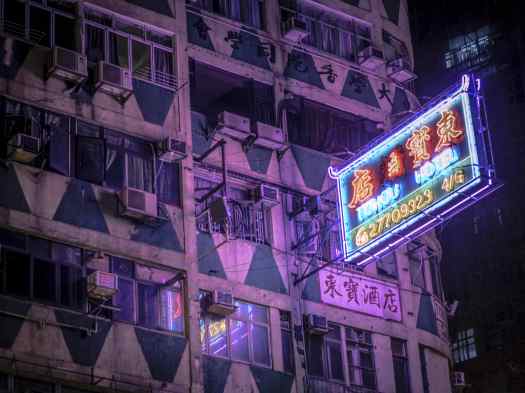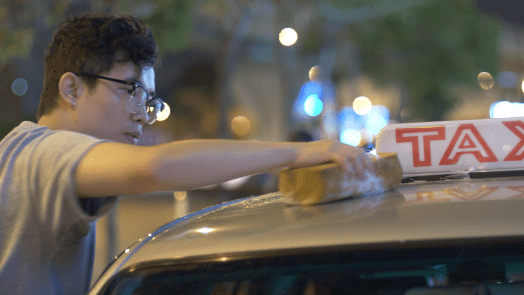It’s a Wednesday night in the dog days of summer. Ah Wai’s taxi, a standard 4-seater Toyota Crown Comfort YXS10, pulls up outside the Canny Man pub on Lockhart Road. The cab’s livery and dashboard ‘for hire’ sign are ablaze with red and its roof light glows a soft yellow amidst the gaudy neon signs of Wanchai. We are taking a road trip into the world of the night shift.

Living by Night
Slightly built, curly-haired, and bespectacled in a pair of Malcolm X horn rims, Ah Wai is 27 years old, younger than the average cabbie. He observes Hong Kong from the unique perspective of one who lives by night: ‘In my eyes, daytime people are busier, always rushing around. Going to work, hustling to wherever they need to go. When night falls, suddenly life seems more relaxed. People slow down when [they’re] crossing the harbour to party in Lan Kwai, seeing friends, having a drink, playing, living a little bit. For some, the long day is over; they’re going home to their kids.’ The nocturnal city seems to exist both separately and in parallel with its diurnal counterpart. ‘Hong Kong is all about being ‘cheap and good’ (peng leng zeng 平靚正). Fast too. Taxis are just like that. Taxis are always there because we work all hours of the day. We work hard – we drive 12 hour shifts! Hong Kong wouldn’t look the same without our red taxis.’

Our band of three is here to document Ah Wai’s shift. We pile into the cab, the roof light flicks off, and we pull away from the curb into Wanchai’s neon fantasyland. Bathed in hues of magenta and electric blue, Ah Wai outlines the simple reasons for becoming a night shift driver. ‘The money’s better, fewer short fares [known in the business as ‘chicken feet’ (gai geuk 雞腳) because there ‘isn’t much meat’], lots of long distance fares [‘chicken thighs’ (gai teui 雞腿) because there is plenty of meat] but my reasons are a little different. People reckon the night shift is tiring and lonely, that you don’t get enough sleep but I like the freedom of the night. Clear roads, long rides. There aren’t many taxis around. It’s quiet and it feels good to drive. It’s safer, it’s peaceful. Driving is comfortable. I don’t feel stress. No fighting for passengers. Plenty of partiers and O.L.s (office ladies) who’ve been working overtime. Every passenger has their own story, their own destination. Life is more colourful at night.’ Ah Wai laughs off the suggestion that this lifestyle has impacted his health: ‘I don’t get much of a tan, I can tell you that! But I sleep eight hours, take vitamin D and wear sunglasses. It’s nothing a day at the beach won’t fix.’

Riding With Drunks and Weirdos
We cruise along Lockhart’s red-light strip with its seedy pubs and girlie bars. Punters spill out onto the sidewalk. A group of teenagers wobble, high heeled and tipsy, amidst traffic. They stop for selfies. ‘I pick up drunks. Weirdos. I’ve had some come in and lay on the floor. I get angry passengers (hai hak 鞋客) too, but they just don’t know any better. Of course us pros know the roads better than they do. I’m a really fast driver and yet riding in my cab is super comfortable. The way I drive is steady. People have praised me for that. They say my service is good. It makes me happy to hear these things.’ We can confirm that Ah Wai, while fast and adept at weaving through traffic, keeps an even pace and never takes corners too sharply.
Ah Wai’s nocturnal nature hasn’t interfered much with his social life: ‘People think you lose all your friends, being a night owl, but my pals come out to meet me at 24-hour joints. After all, when everyone else eats, we get a break too – those are the quiet hours when there are fewer passengers.’ We ride past packed cha chaan tengs and dai pai dongs lit in the murk like luminous bubbles, but these are not the haunts of the night shift driver. For that we must ‘strike the gong’ (go to Causeway Bay, da lo, 打鑼) and cross the harbour or dive (chihm seui 潛水), as cabbies say.
Nighthawks of Kowloon

Ah Wai’s usual stomping grounds, Tsim Sha Tsui and Mong Kok, are still vibrant as midnight strikes. Temple Street Market, its massive gate darkened, has wound down, but the night is young on streets where neighbours eat, gossip, and carouse around folding tables set out on the sidewalk, like a communal living room. For those seeking closer intimacy, these streets are also clearly marked with hot pink fluorescent tubes.

Under cover of night, the industrial area of Kowloon Bay is deserted and eerily quiet, but one flyover shelters a riot of red. Taxis, awash with the scarlet glow of an after hours cafe, are triple parked around the block. A sudden blast of air conditioning and fluorescent light cuts through the muggy night as we push through the diner’s double glass doors. A loudspeaker calls out license plates, in a bored monotone, for cabs that need moving. We are seated at a booth in the back from where we espy the other nighthawks, poking at phones, gesticulating wildly, or slumped to the side French-inhaling smoke. One holds court at a booth across the room, one is dressed in a patterned purple poncho, while another throws his hands in the air and lets off three loud cries – “Waaah! Waaah! Waaaaaaaaaaah!”.
The food is standard fare: a steaming clay pot of minced beef and eggplant, fried pork, and steamed chicken. Strong hot milk tea (naaih chah 奶茶) is a must. And what about the toilet situation? ‘Gas stations and public toilets. Where there are toilets there will be taxis. Take it from me, I know all the districts but on top of that I know where all the toilets are in those districts. Shell’s bathrooms are the cleanest. We’re running around all night, 15 to 20 journeys, and some people get desperate. That’s when we piss in a bottle.’

Tales of a City both Sinister and Beautiful
Refuelled, we head round the corner and pull into an Esso station – an island of light by the side of a highway. Ah Wai gets a red bucket and sponge out of the trunk, fills the bucket with water and gives the taxi a cursory scrub. ‘My car is beautiful (leng 靚). Pristine. All four corners square and intact (sei gok yun zing 四角完整). I’ve been driving for a year, and I’ve had no accidents. Touch wood. I tell you, now that I’ve said this I’m going to “lar ye” (get into a mess 瀨嘢) tonight!’

Says Ah Wai, ‘When it goes past midnight, people start creeping out to the New Territories.’ And so we head north. One never can tell what the night might bring. As we leave the city lights behind, Ah Wai begins to reminisce. ‘In my line of work you see humanity laid bare. I see lots of stories, some good some bad. Once I picked up a hiker halfway up Tai Mo Shan in the middle of the night. Another time I picked up a fare in Wanchai. She was going to Tin Shui Wai. She was on the phone and suddenly became panicked. Her kid had fallen and hit her head. She needed to get to a hospital and she kept on telling me, “Driver dai lo please get me home as fast as you can.” She was really worried so I floored it and got her home. I waited downstairs then took her to QE in Jordan.’ Why didn’t she get an ambulance? ‘Because a red taxi is faster than a white ambulance, duh! (因為紅的實快過白車囉!) Coming away from that I really felt that being a mom isn’t easy. It really got to me.’

As we enter Sai Kung Country Park, the darkness encircles us. Leaving even street lamps behind, we watch for roaming cows. In the secluded country park we each take turns driving the cab – the steering doesn’t have much resistance and the suspension is spongy. A lever topped with a red knob to the right of the driver’s seat opens and closes the left passenger door. We stop by the side of the road and flick off the headlights for a moment. Inky black envelopes us. Swathed in shadow I am struck by the dual nature of darkness, its comforting embrace and the eerie menace of its abyssal void.
‘I’ve never seen anything paranormal, no ghosts, nothing “dirty” (wu zou yeh 污糟嘢), but when I go past a graveyard I drive fast and never look in the rear view, in case I’ve picked up an unwelcome passenger.’

‘I’ve seen some beautiful things, driving at night,’ says Ah Wai as the headlights pierce deeper into the dark woods. ‘Us taxi drivers, we can go places where others can’t. One night I took some fares out to High Island Reservoir. It’s a restricted area. There was a meteor shower. A rain of stars. It’s beautiful to watch the heavens out there.’ Dawn is just about to break as we arrive on the edge of night’s plutonian shore – the east dam wall at High Island. Otherworldly hexagonal rock columns stand, just visible, under the pale light of a full moon. We march at a brisk pace down to Long Ke Wan where we watch night’s veil slowly lift, giving way to the brilliant pinks and oranges of day. Says Ah Wai, ‘Hong Kong is a city that doesn’t sleep. No matter what time it is or where you are, there are stories, and taxis become part of those stories. This is the world I see by night.’


